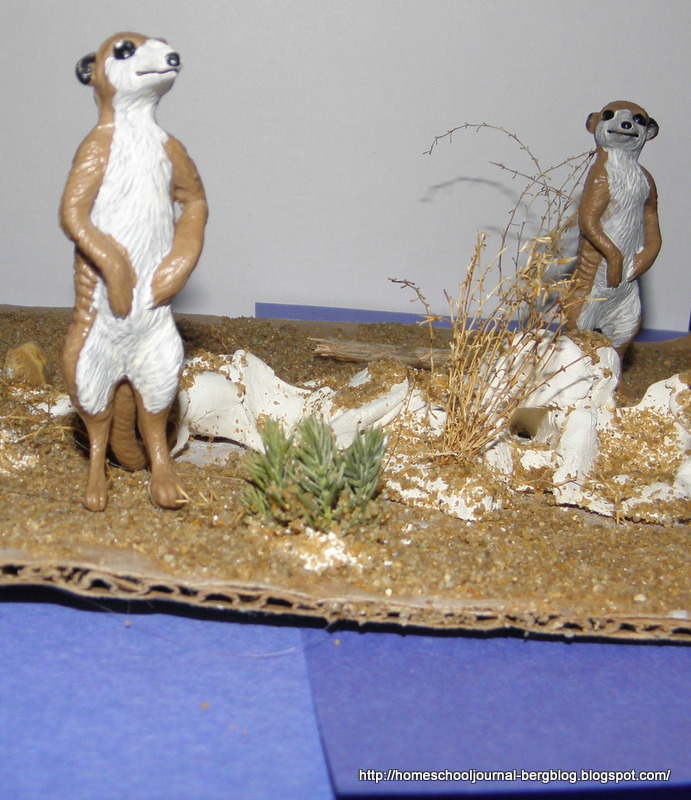Zoology, part 8: Displaying Animals
For their final projects for our unit on zoos, the younger boys made zoo habitat display models. They had to think about what things they needed to include to make the habitat natural and usable for the animals. They had to decide whether they were making a habitat for one type of animals or for more than one type that could live together. They also learned about how zoos make cages without bars. This is a great project for co-ops so that the multiple displays can really look like a zoo when put together on a large table.
Creating Animal Displays
Making Zoo Habitats
There are things to consider when creating animal displays for a zoo.
- Always think of the needs of the animals, the visitors and the zoo keepers.
- Begin by thinking of the animal's needs.
- Make the exhibit as close to the animal's natural habitat as possible
- Make the largest exhibit you feel your zoo can afford. Fewer better exhibits are better than many ones that are too small.
- Avoid making corners where animals might feel trapped.
- The largest side of the exhibit should face the visitors.
- The visitors should be as close as it is safe.
- Animals should be displayed at eye level.
- Make sure there is a way the zookeepers can enter the habitat to take care of the animals' needs.
- The exhibit should clearly state what kind of animal is in the habitat and some information about the animal(s), for one of the purposes of zoos is to inform and educate.
Making Zoo Exhibit Models
Students must decide what materials they want to use to make the displays. First determine the size and scale of your habitat. The best place to start is with your animals. If you are using plastic zoo animals, you might want to purchase them first to determine your scale. We didn't do this and our Meerkats were a bit too large for our display.
Next, decide what materials you want to use. My original plan was to get some bakery boxes with clear windows to use for the displays so that I could store them easily, but my boys had other ideas, so we just used a piece of cardboard for their base. I wanted to make salt dough, but my boys preferred to use clay. I like salt dough because it is inexpensive and it sticks to the cardboard easier than clay. They molded their habitats and one student painted his. Another student glued sand to his habitat and used some additional clay to anchor real pieces of dried sea grass and evergreen to his display.
What ways can your students come up with to make their displays?
Making Cages Without Bars
Bars are a kind of barrier that keep people a safe distance from the animals and keep the animals a safe distance from the people. Unfortunately the bars also make it more difficult to see the animals. Therefore, modern zoos have come up with was to remove the bars but still keep the animals and visitors safe. All of these barriers have a second barrier such as a short wall with hand rail.
- Glass (or plastic) Barriers. Used often for small reptiles, but can also be used for larger animals such as tigers and crocodiles.
- Moat. A large trench that goes around all or part of the animal's enclosure. The animals and visitors are all at the same level. Some moats have water and some are dry. They also have a steep wall on the visitor's side. The size of the moat varies according to the animal -an elephant will not cross a moat more than six feet wide, but a lion needs a moat at least 21 feet across.
- Electrical barriers. Animals quickly learn how far they can go without getting shocked. Best used with small animals like porcupines.
- Thermal Barrier. Freezer coils keep reptiles enclosed as they stay away from cold places
Adding Barriers to the Habitat Models
One student decided that clear plastic would be the best barrier for his bat cave, so we wrapped his cave with plastic wrap to simulate this.
Another student decided that a water barrier would be best for his Meerkat display, so he put blue construction paper under his display to simulate a moat around the habitat.
related posts:
- Saving Zoology
- Introduction and Living vs. Non-living
- Plants, Animals and their Cells
- Classification of Animals
- The Zookeeper's Job
- Animal Care
- The Zoo Curator and Other Jobs at the Zoo
- The History and Purposes of Zoos
sources:
- Interact Simulations: Zooland, Grades 2–5
- Exploring Creation with Biology, Jay Wile
- Exploring Creation with Zoology series, Jeannie Fulbright










